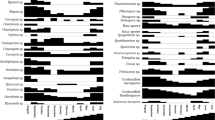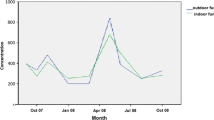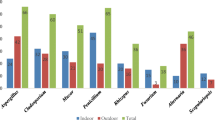Abstract
The frequency of fungal spores in the air of three different sections of a rural bakery was analyzed using a Burkard personal slide sampler and Andersen two stage viable sampler. In average concentration of spores (No./m3) was 228–26770/m3 and concentration of viable colony forming units (CFU/m3) was 65-2061 CFU/m3. Dominant fungus species both culturable and nonculturable, were species of Aspergillus and Penicillium, Cladosporiumsp., Aspergillus niger, Aspergillus flavus, Aspergillus fumigatus, Cladosporium cladosporioides, Penicillium citrinum and Alternaria alternata. Seasonal variations in the spore concentrations were clearly observed in case of some fungi. Total culturable mould concentration of different bakery sections sometimes exceeded the acceptable limit for a healthy indoor environment. Antigenic extracts prepared from some dominant culturable fungi showed high level of allergenicity in skin prick tests indicating that they could be responsible for allergic respiratory dysfunction of bakery workers.
Similar content being viewed by others
References
Cosentino S, Palmas F. Assessment of airborne fungal spores in different industrial working environments and their importance as health hazards to workers. Environ Monitor Assess 1991; 16: 127-136.
Vittal BPR, Glory A. Airborne fungus spores of a library in India. Grana 1985; 24: 129-132.
Singh AB, Singh A. Indoor airborne fungi as important occupational sensitisers in poultry workers. Indoor Built Environ 1996; 5: 138-147.
Singh A, Singh AB. Airborne fungi in a bakery and the prevalance of respiratory disfunction among workers. Grana 1994; 33:3 49-358.
Simeray J, Mandin D, Chaumont JP. Variations in the distribution of fungal spores in the atmosphere of bakehouses. Impact on the study of allergies. Grana 1995; 34: 269-274.
Latgé JP, Paris S. 1991. The fungal spore: reservoir of allergens. In: Cole GT, Hoch HC, eds. The fungal spore and disease initiation in plants and animals. New York: Plenum Press, 1991; 379-401.
Lacey J, Dutkiewicz J. Bioaerosols and occupational lung disease. J Aerosol Sc 1994; 25(8): 1371-1404.
Andersen AA. New sampler for collection, sizing and enumeration of viable airborne particles. J Bact 1958; 76: 471-484.
Stytis DP, Stobo JD, Fudenberg H, Wells JV. Basic and clinical immunology. Lauge Medical Publ Maruzen Asia (Pvt) Ltd, 1982: 409.
Salvaggio J, Aukrust L. Mold induced asthma. J Allergy Clin Immunol 1981; 168: 327-346.
Horéjsí M, Sach J, Tomsíková A, Med A. A syndrome resembling farmer' lung in workers inhaling spores of Aspergillus and Penicillia moulds. Thorax 1960; 15:212-217.
Patterson R, Sommers H, Fink JN. Farmer' lung following inhalation of A. flavus spores growing in mouldy corn-A case study. Clin Allergy 1974; 4: 79-86.
Lacey J. Aerobiology and Healt: the role of airborne fungal spores in respiratory diseases. In: Hawksworth DL. ed. Frontiers in Mycology, Honorary and General Lectures from the Fourth Int. Mycological Congress, Regensburg, 1990: 157-185.
Santra SC, and Chanda S. Airborne fungal flora in indoor environments of the Calcutta metropolis, India. Grana 1989; 28: 141-145.
Chakraverty R. The incidence of Aspergillus parasiticus in the indoor and outdoor environments of Calcutta, India. Grana 1985; 24:133-135.
Levetin E, Horowitz L. A one-year survey of the airborne molds of Tulsa, Oklahoma. I. Outdoor survey. Ann Allergy 1978; 41: 25-27.
Lacey J, Crook B. Fungal and actinomycete spores as pollutants of the workplace and occupational allergens. Ann Occup Hyg 1988; 32: 515-533.
Crook B, Venables KM, Lacey J, Musk AW, Newman Taylor AJ. Dust exposure and respiratory symptoms in a UK bakery. In Griffiths WD. ed. Aerosols-Their generation, behaviour and application. Aerosol Society, Bristol, 1988: 341-345.
Wallerstein G, Bergmann I, Rebohle E, Gemeinhardt H, Thurmer H. Berufliche A temtrakterkrankungen durch Schimmelpilze bei Getreidemullern und Backern. Zeitschrift fur Efkrankungen der Atmungsorgane 1980; 154: 220-233.
Dutkiewicz J. Atmospheric microflora as a harmful factor in bakery working environment. MedycynaWiejska 1983; 9: 85-99.
Reponen T, Nevalainen A, Jantunen MJ, Pelica M, Kalliokoski P. Normal range criteria for indoor air bacteria and fungal spores in a subarctic climate. Indoor air 1992; 2: 26-31.
Gravesen S. Fungi as a cause of allergic disease. Allergy 1979; 34: 135-154.
Lacey J. Indoor aerobiology and health. In: Singh J. ed. Building Mycology. Chapman & Hall, London, 1994: 77-129.
Rao CY, Burge HA, Chang JC. Review of quantitative standards and guidelines for fungi in indoor air. J Air Waste Manag Assoc 1996; 46(9): 899-908.
Herrero B, Zaldivar P. Effects of meteorological factors on the levels of Alternaria and Cladosporium spores in the atmosphere of Palencia, 1990–92. Grana 1997; 36: 180–184.
Larsen TO, Frisvad JC. Production of volatiles and mycotoxins in conidia of common Penicillia and Aspergilli. In: Samson RA et al., eds. Health implications of fungi in indoor environments. Elsevier, Amsterdam, 1994: 251–279.
Sneller MR, Hayes HD, Pinnas JL. Frequency of airborne Alternaria spore in Tucson, Arizona over a 20-year period. Ann. Allergy 1981; 46: 30–33.
Sneiler MR. Mould allergy and climate condition. In: Al-Doory Y, Doinson JF. eds. Mould Allergy. Lea & Febiger, Philadelphia, 1984: 244–266.
Standard PG, Kaufman L. Safety considerations in handling exoantigen extracts from pathogenic fungi. J Clin Microbiol 1982; 15: 663–667.
Lacey J, Nabb S, Webster BT. Retention of actinomyces spores by respirator filters. Ann Occup Hygiene 1982; 25: 351–363.
Author information
Authors and Affiliations
Rights and permissions
About this article
Cite this article
Adhikari, A., Sen, M.M., Gupta-Bhattacharya, S. et al. Incidence of allergenically significant fungal aerosol in a rural bakery of West Bengal, India. Mycopathologia 149, 35–45 (2000). https://doi.org/10.1023/A:1007171420410
Issue Date:
DOI: https://doi.org/10.1023/A:1007171420410




